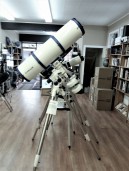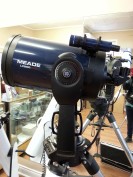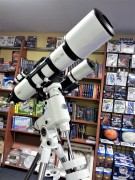General Thoughts:
The most common single-phrased advice I have encountered on the subject of choosing a telescope has been most definitely:
“The best telescope is the one you will use most often.”
Although very true these words only serve to fuel the fire of further initial indecision. The criteria on which one should decide (after much research and discussion) should be based on the following: affordability, portability, maintenance requirements, quality of materials and fabrication and purpose of the equipment. A realistic reply to these questions can only draw you nearer to the final answer.
Other advice that you will hear related to buying a telescope is the importance of:
“aperture, aperture, aperture”.
The aperture is the diameter of the main light gathering lens or mirror. The larger the aperture the more light will enter into the telescope leading to a brighter more detailed view or image. Furthermore, comparing two telescopes of different aperture but with the same magnification, it will be the one with the larger aperture that will show the greater detail. It has been said that aperture is the most important attribute related to choosing a telescope but it is not the only one to consider. With larger aperture comes portability issues.
It is important to realise that no one telescope may be able to completely fulfill your visual and imaging requirements. As your hobby progresses you may want to see more detail or even do some astrophotography. Which ever telescope is chosen it will surely be a compromise unless your budget allows for the luxury of buying more than one.
Realise that the hobby of amateur astronomy could potentially become very costly…take time to choose your equipment well. What ever choice of telescope you do make buy one with the largest aperture you can afford, taking into account portability. Also consider if you are interested in strictly visual or if you would like to do astrophotography as well and if you are interested in the planets or DSO or both. The best planetary views and imaging will be had with a refractor. The best views of DSO would be with a Newtonian and imaging is possible but more difficult due to lack of back focus in some models. The best “all purpose” type telescope which would serve to satisfy both observational astronomy and astrophotography of the Planets and DSO would be the Catadioptric designs…with their individual design pros and cons.
The image through your telescope will never be anyway near textbook quality even if you buy one with a very large aperture. An 8 inch telescope will show great Lunar detail of riffs and valleys, the clouds and belts of Jupiter and some detail of the rings of Saturn, such as the Enke’s division. Also thousands of globular clusters, nebulae and galaxies can be seen but in low detail as “smudges” as some may describe. Many amateur astronomers progress to larger scopes and/or acquire the equipment to “see more” with astrophotography.
The Maksutov-Newtonian design was my choice. I chose this telescope from the Skywatcher brand selection. I was not disappointed. I have good value for the money. Having an F5 focal ratio I found it to be the best compromise for my visual and imaging requirements. One main telescope was really all that I had the intention to buy and it had to suit my needs both visually and for future pursuits in astrophotography on lunar, planetary and DSO objects. A fact not commonly known is that this design most closely approaches the “gold standard” resolution capabilities of a refractor and at significantly less cost. The Maksutov-Newtonian design inherently provides a coma free, large field of view and is a relatively fast scope for imaging. Also there are no additionally required reducers, correctors or diagonals which can potentially further degrade or alter the light transmission. Please be aware however that significantly more expensive brands of this design do exist (as an example, by the Intes company) and that they would certainly provide comparatively better optics leading to still better views and imaging. Regarding portability, the 190mm aperture model really has proven to be at the top of my tolerances. In order to prevent struggling with the assembly, two people are really required to place the telescope on the mount.
For guiding I chose a 70mm Lunt achromatic refractor (instead of an autoguider) which has the added benefit that it can be used for less serious sessions of “pick up and go” viewing and imaging. This scope actually complements my main scope in terms of providing a wider field of view, particularly useful in the imaging of larger galaxies such as Andromeda and diffuse clusters and nebula. However, this refractor not being of an apochromatic design, suffers from chromatic aberration which becomes apparent with the viewing very bright objects.
If ever I would be enticed to buy another telescope in the future it would have to be relatively easy to adapt for astrophotography and serve to supplement, aperture-wise the main telescope that I have now. The Newtonian models although they give more aperture for the money are less suited to astrophotography due to their limitations with back focus in many models. Refractors are not as good visually on DSO but the smaller aperture refractors of around 80 mm (very portable) are both great visually (for their size) on the planets and also have a satisfying field of view for astrophotography on DSO. My next choice would probably be a 14 inch Schmidt-Cassegrain or a Celestron Edge based on their compactness and back focus capabilities, suffering only a little on width of field (correctable with a reducer) and contrast visually as compared to the other above mentioned designs. If your purposes are strictly for viewing and not imaging then nothing beats the Dobsonian for its simplicity of design and value for your money.
A fact to note regarding the aperture of telescopes especially above 200mm, is that the viewing is more susceptible to being degraded due to air turbulence in the atmosphere. A large aperture scope that would render amazing views in the country away from air and light pollution will be less of a performer in the city as well. Also the larger the scope the longer that the air currents within the tube take to even out and the scope to “cool down”.
Larger aperture scopes will provide brighter views, sometimes too bright for our eyes to be able to see any detail. Too bright of a light can harm the eyes permanently. A solution for viewing with larger scopes would be to buy a variable polarizing filter which can be adjusted to accommodate different degrees of brightness. This filter is particularly useful when observing the Moon or the brighter planets such as Jupiter. The filter could even be used during the daytime to view the moon and planets as well…but never the sun unless specialized filters are used which have been certified. Do not use the screw-in sun filter that fits into the eyepiece which may come with department store telescopes…these can cause permanent damage to your eyes.
A note of caution regarding children should be included in this discussion. Never leave children unattended with a telescope. Accidently looking at the sun especially through a telescope without the proper filters could cause permanent damage to the eyes.
As far as astrophotography is concerned, additional requirements must enter into the equation of scope buying. The general goal in this case is to reduce the time required for exposure both for the convenience of the imager (especially in colder weather) and also for the need to stay within the tracking capabilities of the mount and the guiding capabilities of the guiding system (or else star trailing will start to occur). Where as a telescope with a higher focal ratio is better for observational astronomy, one with a lower focal ratio is better for astrophotography. The lower the focal ratio the less time required for exposure. A telescope of a higher focal ratio may be excellent for visual purposes but in terms of longer required imaging time, will be unacceptable. For planetary imaging the focal ratio of the scope is not comparatively an issue in terms of time of exposure required. Today planetary imaging is better done in video and in high frame rate … called “lucky imaging”. DSO imaging on the other hand, is usually done by taking a series of images of long exposures, as DSO are much fainter objects then planets. This is where a telescope of a lower focal ratio is most important…cutting down the imaging time.
In recent years with the advent to the market of increasingly more sensitive cameras, a new way of viewing and imaging has emerged. EAA or Electronically Assisted Astronomy, also called Video Astronomy, has become the middle ground between purely visual astronomy and astrophotography. The focal ratio of a telescope and the precision required of tracking and guiding for imaging, are becoming less important factors in astrophotography. Telescopes of much higher focal ratios (which have better visual views) can now with relatively greater ease, be used for imaging as well, even up to focal ratios of F8 or even F10.
As camera sensitivity improves still further, EAA will surely rival and surpass the image quality derived from that of todays method of long exposure astrophotography. Also, the augmentation of real time observation through the eyepiece has now proven to be possible, as an example the EV Scope by Unistellar Optics. Foreseeably, these innovations will surely lead to future optical systems such as visually-stabilized, handheld camera-telescopes…how would that be for portability!
Web Site Map:
Astronomy Notebook
The Moon
Images And Videos
Equipment and Setup
Notes on Equipment
Astrophotography
An Overview Of The Methods In Astrophotography
Links
Contact
Thanks to: La Maison de l’Astronomie and Lire La Nature Astonomie Plus, for allowing images to be taken of the telescopes on this page.



